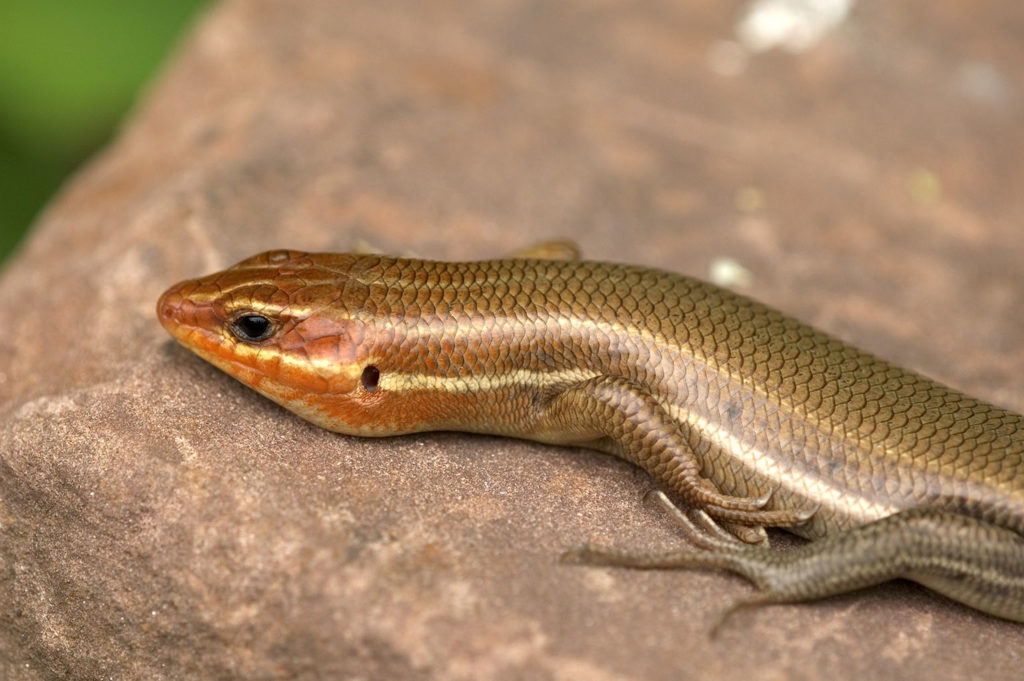Overview
“Where I Live”
Broad-headed skinks are native to the central and southeastern United States. They live in open, moist wooded areas. They are known to inhabit the coastal plain of southern Maryland and the Eastern Shore.
At the Zoo, you can see broad-headed skinks in the Meadow exhibit in Maryland Wilderness.
“How I Live There”
Broad-headed skinks are active during the day but not easily seen because they spend most of their time high in trees, hunting insects and other invertebrates. They are opportunistic predators that have been observed shaking the nests of paper wasps to dislodge pupae. Apparently, they aren’t bothered by wasp stings because the stingers can’t penetrate the smooth, glossy scales that cover their cylindrical bodies.
Despite their short limbs, broad-headed skinks are remarkably swift and agile, and also quite alert, constantly flicking their tongues to pick up chemical signals from the environment. Tongue-flicking lets them “smell” prey and pick up the chemical trail of other skinks (which becomes important during breeding season).
Broad-headed skinks are primarily but not strictly arboreal. They will descend to the ground to hunt, mate, and build nests for egg-laying. They are solitary reptiles that spend most of their time alone, coming together only to mate. In the northernmost parts of their range, they brumate through winter (which effectively means they take cover and become dormant).
“Making My Mark”
Broad-headed skinks are named for the wide jaws that males develop as they mature, which make the head look broad and triangular.
Juveniles are black with brilliant striping and bright blue tails. Females keep some of their striping as they age, but males turn a uniform olive-brown. During mating season, males get swollen heads that also turn bright orange-red.
Broad-headed skinks are the largest lizards in Maryland. They are one of only four skink species and six lizard species native to Maryland.
Raising Young
To female broad-headed skinks, having a swollen head is a positive rather than a negative. When choosing mates, females prefer males with the largest and most brightly colored heads. A male will guard his mate for about one week, aggressively fighting off any other males that try to approach her.
Females build their nests in decaying branches or leaf litter and lay 8 to 13 eggs per clutch. Males mate and run, but females stay in their nests for 8 to 13 weeks, leaving only to feed, guarding the eggs until they hatch. Each egg weighs less than a gram (or a raisin, or a paper clip)! Once the eggs have hatched, the mothers leave, offering no parental care. Baby skinks venture out within a few days and scatter.
“What Eats Me”
Broad-headed skinks are not easy to catch but are preyed upon by carnivorous birds, larger reptiles, and some mammals. If caught, they may bite (and they have a hard bite) or try to escape by dropping their tails. The tail separates from the body and continues to wriggle, hopefully distracting the predator long enough for the skink to dart away. Juveniles have the extra advantage of bright blue tails, which presumably are even more distracting to predators.
Conservation
Broad-headed skinks are listed as a species of least concern by the IUCN, the world’s leading conservation organization. The population of this species is considered stable throughout its range.
Taxonomy
- Kingdom: Animalia
- Phylum: Chordata
- Subphylum: Vertebrata
- Class: Reptilia
- Genera: Plestiodon
- Species: laticeps

